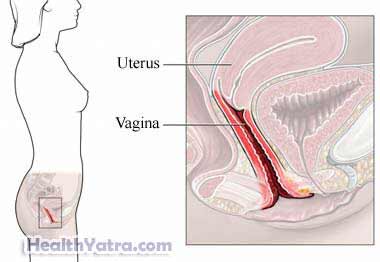Definition
A vaginal yeast infection is caused by a yeast fungus called Candida. While yeast is common in the vagina, it can cause irritating symptoms when it grows excessively.

Causes
Yeast grows in conditions that are less acidic. Vaginal fluids are most often mildly acidic, but this can change. For example, acid levels can decrease during menstrual flow. “Good” bacteria also help keep vaginal secretions acidic and keep yeast levels in check. Conditions that decrease the good bacteria will also increase the chance of a yeast infection.
Risk Factors
Factors that can increase your chance of a yeast infection include:
- Situations that can cause hormonal changes (eg, birth control pills, pregnancy, menopause, steroid use)
- Broad-spectrum antibiotics
- Diabetes, especially when blood sugar is not well-controlled
- A compromised immune system (eg, HIV)
- Perfumed feminine hygiene sprays, deodorant tampons, or bubble bath
- Tight jeans, synthetic underwear, or a wet swimsuit
- Douching
Symptoms
Tell your doctor if you have any of these symptoms:
- Vaginal itching, ranging from mild to severe
- A clumpy, vaginal discharge that may look like cottage cheese
- Vaginal soreness, irritation, or burning
- Rash or redness on the skin outside the vagina
- Painful urination
- Painful sexual intercourse
Diagnosis
Your doctor will:
- Ask you about your medical history and your symptoms
- Do a pelvic exam
- Test vaginal discharge
It is important to see a doctor the first time you have symptoms. Other vaginal infections may have symptoms similar to a yeast infection. These can includebacterial vaginosis and trichomoniasis.
If you have been diagnosed with a yeast infection, you may be able to recognize the signs of a new infection. In this case, it is safe to use over-the-counter medicine. Talk to your doctor if you are unsure.
Treatment
Medication
Various antifungal medicines are available as intravaginal creams, suppositories, and oral medicine. Some examples include:
- Miconazole nitrate (Monistat)
- Clotrimazole vaginal (Gyne-Lotrimin)
- Butoconazole vaginal (Fem-stat)
- Terconazole vaginal (Terazol)
- Clotrimazole vaginal (Mycelex)
- Fluconazole (Diflucan)
If you are diagnosed with a yeast infection, follow your doctor’s instructions.
Prevention
To help reduce your chance of getting a yeast infection, take the following steps:
- Dry the outside vaginal area thoroughly after a shower, bath, or swim.
- Change out of a wet bathing suit or damp workout clothes as soon as possible.
- Wear cotton underwear.
- Avoid tight-fitting clothing.
- Don’t douche unless your doctor tells you to do so; it decreases vaginal acidity.
- If you have diabetes, try to control your blood sugar.
- Avoid bubble baths, perfumed feminine hygiene sprays, and scented soap.
- Avoid frequent or prolonged use of antibiotics if possible.
